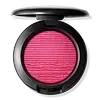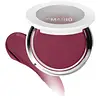Mac Cosmetics Extra Dimension Hybrid Cream Powder Blush Versus Makeup by Mario Soft Pop Plumping Blush Veil
What's inside
What's inside
 Key Ingredients
Key Ingredients

 Benefits
Benefits

 Concerns
Concerns

 Ingredients Side-by-side
Ingredients Side-by-side

Mica
Cosmetic ColorantCetearyl Ethylhexanoate
EmollientC12-20 Acid PEG-8 Ester
EmulsifyingHdi/Trimethylol Hexyllactone Crosspolymer
Squalane
EmollientGlycerin
HumectantChondrus Crispus Extract
Skin ConditioningEthylhexylglycerin
Skin ConditioningDicalcium Phosphate
AbrasiveSilica
AbrasiveTin Oxide
AbrasiveSynthetic Fluorphlogopite
Polysorbate 80
Emulsifying1,2-Hexanediol
Skin ConditioningCaprylyl Glycol
EmollientCI 77891
Cosmetic ColorantCI 77491
Cosmetic ColorantCI 77492
Cosmetic ColorantCI 77499
Cosmetic ColorantCI 77163
Cosmetic ColorantCI 42090
Cosmetic ColorantCI 75470
Cosmetic ColorantCI 77289
Cosmetic ColorantCI 77288
Cosmetic ColorantCI 77510
Cosmetic ColorantCI 77742
Cosmetic ColorantCI 15850
Cosmetic ColorantCI 45410
Cosmetic ColorantCI 73360
Cosmetic ColorantCI 77007
Cosmetic ColorantCI 19140
Cosmetic ColorantCI 15985
Cosmetic ColorantMica, Cetearyl Ethylhexanoate, C12-20 Acid PEG-8 Ester, Hdi/Trimethylol Hexyllactone Crosspolymer, Squalane, Glycerin, Chondrus Crispus Extract, Ethylhexylglycerin, Dicalcium Phosphate, Silica, Tin Oxide, Synthetic Fluorphlogopite, Polysorbate 80, 1,2-Hexanediol, Caprylyl Glycol, CI 77891, CI 77491, CI 77492, CI 77499, CI 77163, CI 42090, CI 75470, CI 77289, CI 77288, CI 77510, CI 77742, CI 15850, CI 45410, CI 73360, CI 77007, CI 19140, CI 15985
C15-19 Alkane
SolventOctyldodecanol
EmollientTridecyl Trimellitate
EmollientPentaerythrityl Tetraisostearate
EmollientSynthetic Wax
AbrasiveSynthetic Fluorphlogopite
Raphanus Sativus Seed Extract
Skin ConditioningMicrocrystalline Wax
Emulsion StabilisingSilica Silylate
EmollientHydrogenated Rice Bran Wax
Skin ConditioningDicalcium Phosphate
AbrasiveDisteardimonium Hectorite
StabilisingHelianthus Annuus Seed Oil
EmollientOryza Sativa Bran Wax
Skin ConditioningPentaerythrityl Tetra-Di-T-Butyl Hydroxyhydrocinnamate
AntioxidantRosmarinus Officinalis Leaf Extract
AntimicrobialTocopheryl Acetate
AntioxidantRicinus Communis Seed Oil
MaskingHydrolyzed Sodium Hyaluronate
Skin ConditioningSodium Hyaluronate
HumectantHydrogenated Castor Oil
EmollientCI 77891
Cosmetic ColorantCI 77491
Cosmetic ColorantCI 42090
Cosmetic ColorantCI 15850
Cosmetic ColorantCI 19140
Cosmetic ColorantC15-19 Alkane, Octyldodecanol, Tridecyl Trimellitate, Pentaerythrityl Tetraisostearate, Synthetic Wax, Synthetic Fluorphlogopite, Raphanus Sativus Seed Extract, Microcrystalline Wax, Silica Silylate, Hydrogenated Rice Bran Wax, Dicalcium Phosphate, Disteardimonium Hectorite, Helianthus Annuus Seed Oil, Oryza Sativa Bran Wax, Pentaerythrityl Tetra-Di-T-Butyl Hydroxyhydrocinnamate, Rosmarinus Officinalis Leaf Extract, Tocopheryl Acetate, Ricinus Communis Seed Oil, Hydrolyzed Sodium Hyaluronate, Sodium Hyaluronate, Hydrogenated Castor Oil, CI 77891, CI 77491, CI 42090, CI 15850, CI 19140
Ingredients Explained
These ingredients are found in both products.
Ingredients higher up in an ingredient list are typically present in a larger amount.
Ci 15850 is the pigment color red. It is an azo dye and created synthetically.
Azo dyes need to be thoroughly purified before use. This allows them to be more stable and longer-lasting.
This ingredient is common in foundations, lipsticks, and blushes. This color is described as brown/orangey red.
It has many secondary names such as Red 6 and Red 7. According to a manufacturer, Red 6 usually contains aluminum.
Learn more about CI 15850CI 19140 is also known as Tartrazine. Tartrazine is a synthetic dye used in cosmetics, foods, and medicine to add a yellow color.
Tartrazine is created from petroleum and is water-soluble.
Some people may experience allergies from this dye, especially asthmatics and those with an aspirin intolerance.
Learn more about CI 19140Ci 42090 is a synthetic dye created from petroleum. It is used to give a bright blue color to cosmetics, medicine, and food.
Ci 77491 is also hydrated iron III oxide. It's sole purpose is to give a red/pink hue to products.
Iron III oxides are classified as inorganic chemicals for coloring.
Synthetically created Ci 77491 is considered safer than those naturally found. This is because the synthetically created version may contain less impurities. Iron oxides are generally non-toxic and non-allergenic.
Learn more about CI 77491Ci 77891 is a white pigment from Titanium dioxide. It is naturally found in minerals such as rutile and ilmenite.
It's main function is to add a white color to cosmetics. It can also be mixed with other colors to create different shades.
Ci 77891 is commonly found in sunscreens due to its ability to block UV rays.
Learn more about CI 77891Dicalcium Phosphate is an exfoliant.
Synthetic Fluorphlogopite is the synthethic version of mica. It consists of fluorine, aluminum and silicate.
Synthetic Fluorphlogopite is used to add volume to products.
It is considered non-irritating on the skin.
Learn more about Synthetic Fluorphlogopite